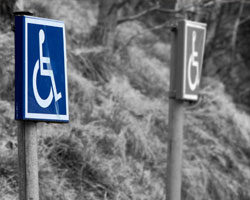 Implications for Learning
Implications for Learning
Physical disability may have an impact on some or all activities to a greater or lesser extent. Students with physical disabilities may have problems related to movement, posture (e.g., sitting, standing), grasping or manipulating objects, communication, eating, perception, reflex movements, and/or automatic motricity (e.g., sphincter, intestinal muscles).
The initial barrier experienced by many students with physical disabilities is physically accessing the learning environment itself. For many students with physical disabilities the inaccessibility of buildings and surrounding areas is a problem.4
Students with physical disabilities and neurological conditions may also have perceptual difficulties that can take various forms. Some students have difficulty actually receiving information by hearing or sight, while others can see or hear, but cannot process the information they receive. This can cause difficulties with reading and writing, such as locating the correct place on the page, or moving from left to right when reading and writing.
Students with a neurological condition, and who may also have a physical disability, may have speech and language difficulties, along with students who are deaf, or who have partial hearing, may have difficulty communicating through speech. People with communication difficulties are often thought to be far less able than they really are. It is important to avoid making quick judgments about these students to ensure that automatic assumptions are not being made concerning a student’s intelligence and ability if their speech is very slow, slurred, or if they are non-verbal. The potential of these students often goes unrecognized. Berry and Domene (2015) observed that students with physical disabilities report that support from postsecondary faculty and staff along with environmental and material supports to be important for achieving success in their postsecondary studies.
The following accommodations and classroom adaptations are a list of suggested accommodations, but are not comprehensive or exhaustive, nor will all accommodations listed be necessary in all cases. Other accommodations may be implemented based on the individual needs of each student as recommended by your campus Disability Services Office or other professionals.
| Common Characteristics of a Student with Physical Disabilities | Commonly Suggested Accommodations/Classroom Adaptations |
|---|---|
| Has unique needs in terms of physical space or has difficulty using chairs/tables in the classroom/lab. | Create a physically accessible environment that is not mobility-limited. |
| Student needs specialized transportation. | Be flexible with the schedule. Students may arrive late or have to leave before the class is over due to adapted transportation services. |
| Is often physically unable to hold a pen and write for extended periods of time or may experience challenges with input, output, and information processing when working on assignments, tests, and/or exams. | Replace written exams or assignments with an oral exam or presentation. Use of note takers. Use of assistive technology (e.g., computer, assistive software, mini recorder, etc.). 5 Use of a scribe or speech-to-text software to record answers on tests/exams. Provide a room other than the classroom for exams if required. |
| Student has difficulty finishing assignments and/or tests in allotted time. | Extra time for tests/exams and perhaps some components of coursework. |
| Experiences fatigue and limited mobility when speaking to a person for a long period of time. | When speaking to a person who uses a wheelchair for a long period of time, avoid the need for them to strain in order to look up at you by sitting beside or leaning toward them during the conversation, in order for them to avoid experiencing fatigue and/or pain. |
| Requires extra time to obtain formats compatible with assistive technology. | Provide digital copies of texts. (It is very important to provide students with a complete list of reference documents as early as possible or prior to the start of the semester). |
| Feels excluded during group exercises or has difficulty moving around the classroom. | Make sure that the person is always included with others when forming groups. |
| Expends a great deal of energy to complete daily tasks. | To reduce fatigue of students with physical disability, it may be helpful to limit the number of exams on a given day or week. Extra time should be planned for oral reports on occasion if the person has diction problems. Perhaps suggest a reduced course load. |
| Experiences challenges with daily living activities and mobility. | Ensure all off-site activities are accessible or provide alternative assignment options. Individuals with a motor disability sometimes use a service animal, which is usually trained to respond to unique commands. (It is preferable to ask permission before you pet the service animal). |